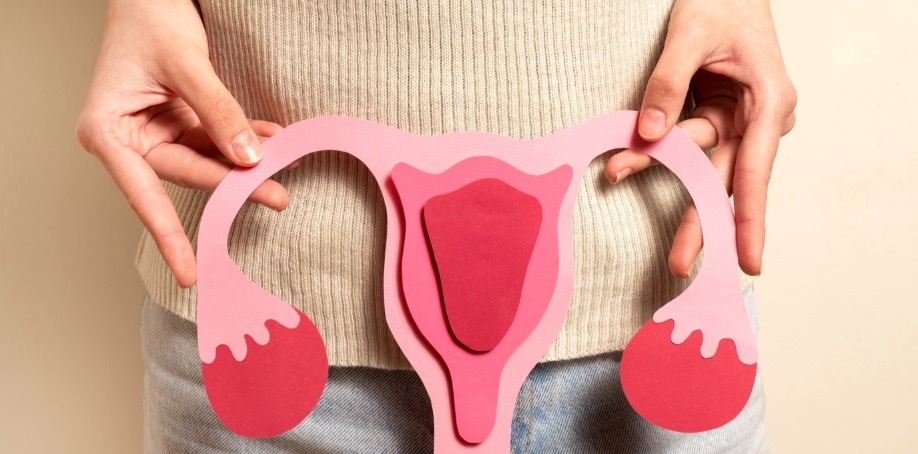The Luteal Phase: Explore the Depths of Your PMS Week

Dr Disha Sridhar
I am a Gynaecologist Obstetrician ( MD, DNB OBGYN) with an emphasis on INTEGRATIVE MEDICINE.

Welcome to the captivating realm of the luteal phase—a time of transformation and introspection. Understanding the luteal phase is more than biology; it's a journey of self-discovery and self-compassion. By unraveling its mysteries, we empower ourselves to navigate emotions with grace. Let's explore the emotional significance of the luteal phase and embrace its ebbs and flows.
The Luteal phase of the menstrual cycle: A Kaleidoscope of Emotions
The luteal phase brings a kaleidoscope of emotions. Hormonal shifts influence moods, sensitivity, and nurturing instincts:
- Elation and Vitality: Early luteal phase fills us with energy and creativity.
- Sensitivity and Introspection: We become more introspective, seeking solace in self-reflection.
- Nurturing and Compassion: Our hearts expand, fostering compassion and kindness.
- Vulnerability and Sensitivity: Heightened emotional sensitivity leads to cathartic releases.
Navigating the Luteal Phase: Embracing Self-Care and Emotional Well-being
During the luteal phase, self-care and emotional well-being are essential. Incorporate practices such as self-reflection, gentle movement, nourishing nutrition, relaxation techniques, connection with loved ones, and self-compassion.
What is the Luteal Phase of the menstrual cycle? Embracing the Transformation Within
The Luteal Phase: A Time of Preparation
The luteal phase is the second half of the menstrual cycle, following ovulation. It is a period of preparation, setting the stage for potential pregnancy. Lasting around 10 to 16 days, this phase marks a significant shift in hormone production and uterine lining development.
Key Hormonal Changes
During the luteal phase, two primary hormones play a crucial role: estrogen and progesterone. As ovulation occurs, estrogen levels begin to decline, while progesterone levels rise. This hormonal interplay creates a fertile ground within the body, priming it for the possibility of conception.
The Role of the Corpus Luteum
At the heart of the luteal phase lies the corpus luteum—a temporary endocrine structure that forms from the remains of the ovarian follicle after ovulation. This tiny powerhouse produces progesterone, a hormone vital for maintaining a supportive environment for a potential pregnancy.
The corpus luteum acts as a nurturing guardian, ensuring the uterine lining becomes thick and rich with blood vessels, preparing it to receive a fertilized egg. If pregnancy occurs, the corpus luteum continues to produce progesterone to sustain the developing embryo until the placenta takes over.
Embracing the Emotional Journey
Beyond its physiological intricacies, the luteal phase carries emotional significance. Hormonal fluctuations during this phase can influence our mood, emotions, and perceptions of the world around us. It is a time when we may experience a wide range of feelings, from excitement and anticipation to vulnerability and introspection.
These emotional shifts are a natural part of the luteal phase and reflect the profound connection between our reproductive system and our emotional well-being. Embracing this emotional journey allows us to gain a deeper understanding of ourselves, fostering self-compassion and nurturing our inner selves.
Hormonal Changes during the Luteal Phase: Unveiling the Inner Symphony
Estrogen Levels and Their Effects
During the luteal phase, estrogen levels undergo intricate fluctuations, creating a symphony of hormonal dance within our bodies. Let's explore the variations in estrogen levels and their profound effects on our emotional well-being.
- Fluctuations and Emotional Impact: Changing estrogen levels influence mood and energy levels, leading to emotional shifts during this phase.
- Physical Symptoms: Estrogen imbalances can cause physical symptoms like breast tenderness and bloating, affecting our perception of body and emotions.
- Debunking Misconceptions: It's important to understand that not all symptoms are solely attributed to estrogen and that experiences vary.
Progesterone Levels and Their Effects
The rise and fall of progesterone during the luteal phase add depth to the hormonal symphony, creating a transformative experience within our bodies. Let's explore the role of progesterone and its effects during this phase.
- Preparing the Uterus for Pregnancy: Rising and falling progesterone levels create a nurturing environment in the uterus, ready for a fertilized egg.
- Symptoms and Sensitivity: Fluctuating progesterone levels can lead to fatigue, mood swings, and changes in appetite.

The Length of the Luteal Phase: A Harmonious Dance
The luteal phase, like a mesmerizing dance, typically lasts between 10 to 16 days. However, it's important to note that individual experiences may vary. Let's explore the factors that can influence the duration and variability of this transformative phase.
- Influencing Factors: Various factors can impact the length of the luteal phase. Hormonal imbalances, stress levels, lifestyle choices, and underlying health conditions can all play a role in altering the timing of this phase.
- Potential Implications of a Shorter Luteal Phase: A shorter luteal phase, known as luteal phase deficiency, may have implications for fertility and conception. It can affect the uterus' ability to maintain a nourishing environment for a potential pregnancy. Seeking medical advice can provide guidance and support if you have concerns about a shorter luteal phase.
- Potential Implications of a Longer Luteal Phase: Conversely, a longer luteal phase may also warrant attention. While a slightly extended phase is usually not a cause for concern, significantly longer phases could be an indication of hormonal imbalances or other underlying factors. Consulting with a healthcare professional can provide insights and guidance for managing a longer luteal phase.
Embracing the Natural Rhythm
It's crucial to honor the natural rhythm of our bodies during the luteal phase, recognizing that each person's experience is unique. By understanding the factors that can influence the length and timing of this phase, we can navigate its transformative journey with greater self-awareness and self-compassion.

Symptoms and Changes During the Luteal Phase: Riding the Emotional Waves
Premenstrual Syndrome (PMS): Embracing the Rollercoaster
PMS accompanies the luteal phase, bringing a range of physical and emotional symptoms. Discover the connection between PMS and this phase, and find natural ways to manage symptoms.
- The Hormonal Dance: PMS is closely tied to the hormonal fluctuations of the luteal phase, impacting our well-being.
- Physical and Emotional Symptoms: From bloating to mood swings, PMS presents various symptoms that vary in intensity.
- Natural Management: Prioritize self-care, stress reduction, balanced diet, and exercise to support well-being during the luteal phase.
Premenstrual Dysphoric Disorder (PMDD): Conquering the Emotional Storm
PMDD intensifies emotional distress during the luteal phase. Differentiate it from PMS, understand its impact, and explore treatment options.
- The Intensity of PMDD: PMDD brings severe emotional and physical symptoms that disrupt daily life.
- The Luteal Phase and PMDD: The luteal phase amplifies PMDD symptoms, calling for understanding and management.
- Treatment and Support: Seek professional guidance for personalized treatment options and support to manage PMDD effectively.

Tracking and Monitoring the Luteal Phase: Unveiling the Inner Patterns
Tracking and monitoring the luteal phase uncovers the secrets of our menstrual cycle, revealing profound insights into fertility and reproductive health. Let's explore tracking methods, the benefits of monitoring, and popular apps for this transformative journey.
- Methods for Tracking: From calendars to BBT charting, cervical mucus observations, and OPKs, each method offers unique perspectives on the luteal phase.
- Benefits of Monitoring: Monitor the luteal phase to pinpoint ovulation, identify fertility windows, and assess reproductive health, empowering informed decisions.
- Popular Apps and Tools: Embrace the digital age with apps like Flo, Clue, and Kindara. Enjoy cycle tracking, symptom logging, and personalized insights for a transformative tracking experience.
Supporting a Healthy Luteal Phase: Nurturing Inner Harmony
Supporting a healthy luteal phase is essential for emotional well-being. Explore the influence of lifestyle factors and discover natural remedies for nurturing your inner harmony.
- Lifestyle Factors: Cultivate balance through diet, exercise, and stress management. Embrace nutrient-rich foods, engage in moderate exercise, and find stress relief techniques that resonate with you.
- Natural Remedies: Harness the power of nature with vitamins, minerals, and herbal remedies. Explore the benefits of B6, E, magnesium, zinc, chasteberry, evening primrose oil, and dong quai.
- Cautionary Notes: Seek professional advice for proper dosage and potential interactions with medications or health conditions. Be informed and prioritize your well-being.
Nurture your inner harmony, support a healthy luteal phase, and embrace the emotional power of balanced well-being.

Embrace Your Luteal Phase Journey with Emotional Resilience
In conclusion, understanding and embracing your luteal phase journey is vital for your emotional well-being. Let's recap the key points:
- We explored the definition, hormonal changes, and duration of the luteal phase, recognizing its significance in women's health.
- We delved into the emotional aspects of premenstrual syndrome (PMS) and premenstrual dysphoric disorder (PMDD), acknowledging the physical and emotional symptoms experienced during this phase.
- Tracking and monitoring the luteal phase empowers you to gain self-awareness, optimize fertility tracking, and ensure reproductive health.
By understanding your luteal phase, you gain insight into your body's unique rhythms and emotions. It allows you to navigate the ebb and flow of your menstrual health with confidence and emotional resilience.
Remember to track your own luteal phase, paying attention to any changes or concerns. If you have questions or experience significant disruptions, seek professional advice from a healthcare provider. They can provide personalized guidance and support tailored to your needs.
Embrace your luteal phase journey with confidence, resilience, and emotional well-being. Honor the beauty of your body's rhythms, prioritize self-care, and nurture your inner harmony. By embracing and understanding your luteal phase, you embark on a transformative path toward holistic well-being.
FAQs
The average length of the luteal phase is typically around 10 to 16 days. However, it's important to remember that individual variations are common, and the length may differ for each person. Embrace the uniqueness of your body's rhythms.
- A. Yes, stress can impact the length and regularity of the luteal phase. Excessive stress can disrupt hormonal balance and potentially lead to irregularities in the menstrual cycle. Prioritizing stress management techniques can support a healthier luteal phase.
A. Absolutely! Making positive lifestyle changes can help alleviate PMS symptoms during the luteal phase. Incorporating a balanced diet, regular exercise, stress reduction techniques, and getting adequate sleep can all contribute to mitigating PMS symptoms. Embrace these changes and nurture your well-being.
A. Yes, hormonal birth control methods can affect the luteal phase. Different types of hormonal contraceptives can alter hormone levels and potentially impact the length and regularity of the luteal phase. It's important to consult with a healthcare professional for personalized guidance and understanding.
A. Yes, it is normal to experience spotting or irregular bleeding during the luteal phase for some individuals. Light spotting or minor irregularities can occur due to hormonal fluctuations. However, if you have concerns or the bleeding is excessive or persistent, it's always advisable to consult with a healthcare professional for further evaluation.
